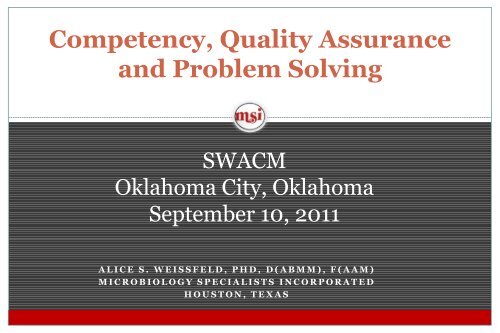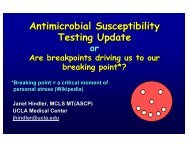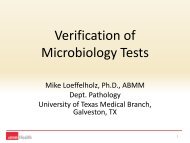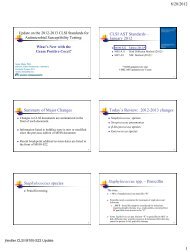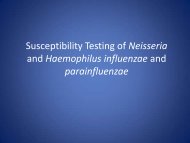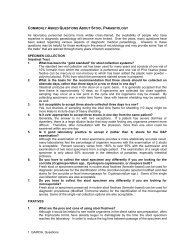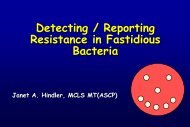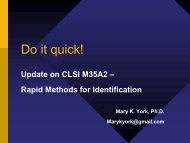Quality System Essentials in Clinical Microbiology - SWACM
Quality System Essentials in Clinical Microbiology - SWACM
Quality System Essentials in Clinical Microbiology - SWACM
- No tags were found...
You also want an ePaper? Increase the reach of your titles
YUMPU automatically turns print PDFs into web optimized ePapers that Google loves.
QSE #1 Organization and ManagementThe lab must be a legal entity that is free of anyf<strong>in</strong>ancial or political conflicts of <strong>in</strong>terest
QSE #2 <strong>Quality</strong> Management <strong>System</strong>The Lab must:• participate <strong>in</strong> an external proficiency test<strong>in</strong>g program• perform <strong>in</strong>ternal audits• have a system for corrective action when errors occur
QSE #3 Document Control• Each SOP should be reviewed by the Laboratory Director atleast annually• No document should be changed unless approved by theLaboratory Director or designee• There should be a master list of documents that show whichdocuments are currently <strong>in</strong> use, their revision number andthe date of the revision
QSE #3 Document Control Revision ExampleON-THE-JOB-TRAINING Approved by: ASW:PHV:ETEffective Date: 05/08/96Revision Date: 2/22/2011Adm<strong>in</strong>istrative:CC070.02REVISION HISTORYDocument # Date DescriptionCC070.01 6/4/2010 Added to document tra<strong>in</strong><strong>in</strong>g of specificprocedures and a 6 month competency.Reworded how employees are releasedto a bench. Converted the appendix oflists of procedures conta<strong>in</strong>ed <strong>in</strong> eachbench to a checklist used to documenttra<strong>in</strong><strong>in</strong>g done.CC070.02 2/22/2011 Tra<strong>in</strong><strong>in</strong>g and Assessment formresequenced and revised
QSE #4 Review of Contracts• With managed care organizations• With the medical staff e.g. what the physicians have agreedto <strong>in</strong> terms of reflex test<strong>in</strong>g, turn-around time for stat test<strong>in</strong>g
QSE #5 Evaluation of Referral Labs• The lab must have a procedure for evaluat<strong>in</strong>g and select<strong>in</strong>greferral labs e.g., ask for copies of the lab’s PT (proficiencytest<strong>in</strong>g) results
QSE #6 Evaluation of Vendors• Instrument or product should be approved or cleared by theFDA• Vendor ISO 9000: 2005 or ISO 13485 accredited
QSE #7 Cl<strong>in</strong>ical Consultant Must be Available• The lab must provide cl<strong>in</strong>ical <strong>in</strong>terpretations as requested bycl<strong>in</strong>icians
QSE #8 Resolution of Compla<strong>in</strong>ts• Documentation should <strong>in</strong>clude:• The nature of the compla<strong>in</strong>t• Date of occurrence• Individuals <strong>in</strong>volved• Nature of <strong>in</strong>vestigation• Resolution of the problem
QSE#9 Control of Nonconformities (errors)• Record the problem• Determ<strong>in</strong>e the root cause• Document corrective action e.g., us<strong>in</strong>g expired reagents,modify<strong>in</strong>g test procedure without approval, specimen set upeven though it was not transported properly
QSE #10 Corrective Action• Document the effectiveness of corrective action over time
QSE#11 Preventive Action• Establish a program to reduce the likelihood ofnonconformance• Accomplished by regular review of data generated from rout<strong>in</strong>e QCtest<strong>in</strong>g of reagents and proficiency test<strong>in</strong>g.
QSE #12 Cont<strong>in</strong>ual Improvement• Review all operational procedures at least annually with thegoal of improv<strong>in</strong>g all SOPs as necessary
QSE #13 <strong>Quality</strong> and Technical Records• These <strong>in</strong>clude:• Patient test requisitions• Patient test reports• Instrument pr<strong>in</strong>touts• QC records• Records of specimens sent to reference labs• Nonconformity records• Compla<strong>in</strong>t records• Record of corrective action
QSE #14 Internal and External Audits• Verify that lab is <strong>in</strong> compliance with its quality programExternal audits usually occur every 2 years by an outside agencyInternal audits are performed by staff May be done us<strong>in</strong>g checklists from each microbiology section Internal audits should be discussed with lab personnel
QSE #15 Personnel• Ma<strong>in</strong>ta<strong>in</strong> job descriptions• Should <strong>in</strong>clude required qualifications, experience, education, tra<strong>in</strong><strong>in</strong>gand professional certifcation• Provide adequate on-the job- tra<strong>in</strong><strong>in</strong>g• Provide cont<strong>in</strong>u<strong>in</strong>g education• Assess staff competency
Why are Tra<strong>in</strong><strong>in</strong>g and Competency so Important?•Medical errors <strong>in</strong> which the laboratory is <strong>in</strong>volvedhave been attributed to:•Tra<strong>in</strong><strong>in</strong>g not be<strong>in</strong>g provided•Tra<strong>in</strong><strong>in</strong>g be<strong>in</strong>g <strong>in</strong>effective
CAP Q Probes Program• 1996 CAP-Q Probes Program: Three part study ofemployee competency assessment practices by the Collegeof American Pathologists (CAP) <strong>in</strong>cluded:• Current competency assessment practices• Evaluation of compliance with laboratory’s own practices us<strong>in</strong>gpersonnel records• Written appraisal of the competence of 5 specimen processors per<strong>in</strong>stitution
CAP Q Probes ProgramQ Probes Results from 552 Institutions• Institutions with a written competency plan 89.2%• Institutions follow<strong>in</strong>g their written plan <strong>in</strong> the lab 90.3%• Institutions review<strong>in</strong>g employee competency at least annually 98.0% Through direct observation 87.5% Through review of test or QC results 77.4% Through review of <strong>in</strong>strument PM 60.0% Through written test<strong>in</strong>g (poorest <strong>in</strong>dicator) 52.2%Additional Survey Information: 6.4% failed to comply with their own lab’s plan 8.6% of employees failed their competency assessment but were allowed to cont<strong>in</strong>uetheir usual work
Summary of Competency AssessmentItems That Must be Included <strong>in</strong> a Competency AssessmentProgram Direct observation of rout<strong>in</strong>e patient test performance• Description: This is the actual observation of work as it is be<strong>in</strong>g performed bythe laboratory staff. Not limited to test performance but <strong>in</strong>clude all processes<strong>in</strong> which the employee is <strong>in</strong>volved, <strong>in</strong>clud<strong>in</strong>g specimen collection, preparation,as well as the actual test<strong>in</strong>g of the specimens.• Examples: Used for areas <strong>in</strong>volv<strong>in</strong>g a higher degree of decision mak<strong>in</strong>g orhav<strong>in</strong>g a significant impact on patient care (e.g., new positive blood cultures,positive cerebrosp<strong>in</strong>al fluid specimens, susceptibility test<strong>in</strong>g, accurate<strong>in</strong>terpretation of test reactions, follow<strong>in</strong>g appropriate work <strong>in</strong>structions)
Summary of Competency AssessmentItems That Must be Included <strong>in</strong> a Competency AssessmentProgram Monitor<strong>in</strong>g the record<strong>in</strong>g and report<strong>in</strong>g of test results• Description: Review of patient results for the proper and correct record<strong>in</strong>gand report<strong>in</strong>g• Examples: This can be accomplished by the documentation of observation ofan employee writ<strong>in</strong>g or enter<strong>in</strong>g patient test results on report forms or <strong>in</strong>tothe computer or by review of worksheets with report forms or computerentries.
Summary of Competency AssessmentItems That Must be Included <strong>in</strong> a Competency AssessmentProgram Review of test results, QC records, proficiency test<strong>in</strong>g results,and preventive ma<strong>in</strong>tenance records• Description: One must review patient results.• Examples: This can be accomplished by review of worksheets or computerentries for accurate record<strong>in</strong>g of patient results, review of QC worksheets orpr<strong>in</strong>touts for acceptable results (with<strong>in</strong> QC parameters) and for review ofpreventive ma<strong>in</strong>tenance records for the appropriate and timely checks anddocumentation.
Summary of Competency AssessmentItems That Must be Included <strong>in</strong> a Competency AssessmentProgram Direct observation of performance of <strong>in</strong>strument ma<strong>in</strong>tenanceand function checks• Description: Direct observation must be used when employees areperform<strong>in</strong>g ma<strong>in</strong>tenance procedures and check of <strong>in</strong>struments.• Examples: One must directly observe an employee when perform<strong>in</strong>gma<strong>in</strong>tenance procedures and function checks on <strong>in</strong>struments <strong>in</strong> thelaboratory, such as the automated identification/susceptibility test<strong>in</strong>g<strong>in</strong>strument, molecular diagnostic <strong>in</strong>strumentation, and blood culture<strong>in</strong>strumentation.
Summary of Competency AssessmentItems That Must be Included <strong>in</strong> a Competency AssessmentProgram Assessment of test performance through test<strong>in</strong>g previouslyanalyzed specimens, <strong>in</strong>ternal bl<strong>in</strong>d test<strong>in</strong>g samples, or externalproficiency test<strong>in</strong>g samples• Description: One must assess employee competence by giv<strong>in</strong>g them unknownsamples to evaluate as they would evaluate patient samples <strong>in</strong> the laboratory.• Examples: This can be accomplished by split-sample analysis, previouslyanalyzed specimens, bl<strong>in</strong>d <strong>in</strong>ternal proficiency test<strong>in</strong>g, or externalproficiency test<strong>in</strong>g such as CAP surveys, etc.
Summary of Competency AssessmentItems That Must be Included <strong>in</strong> a Competency AssessmentProgram Assessment of problem-solv<strong>in</strong>g skills• Description: One must assess the ability of employees to solveproblems that arise dur<strong>in</strong>g their culture analysis.• Examples: This can be accomplished by (i) ask<strong>in</strong>g the employees towrite up a situation where they had to solve a problem that related toan <strong>in</strong>vestigation they performed or (ii) giv<strong>in</strong>g a fictitious (or real)example of a problem encountered <strong>in</strong> the laboratory and ask<strong>in</strong>g theemployee how he or she would handle the situation.
Tra<strong>in</strong><strong>in</strong>g, Evaluation and Assessment Tools• MSI Adm<strong>in</strong>istrative Procedure CC070• MSI Employee Tra<strong>in</strong><strong>in</strong>g and Assessment Record Form• MSI employee competency Evaluation Form
Adm<strong>in</strong>istrative Procedure CC070:On the Job Tra<strong>in</strong><strong>in</strong>gON-THE-JOB-TRAINING Approved by: ASW:PHV:ETEffective Date: 05/08/96Revision Date: 10/24/08Adm<strong>in</strong>istrative: CC070I. PRINCIPLE:To assure that all technical staff are adequately tra<strong>in</strong>ed, an on-the-job tra<strong>in</strong><strong>in</strong>g program (OJT) hasbeen developed. This procedure outl<strong>in</strong>es the steps <strong>in</strong>volved.II. PROCEDURE:A. The Laboratory Director will assess all technical employees at the time of employment for theirsuitability to perform cl<strong>in</strong>ical test<strong>in</strong>g. Individuals with appropriate education and professionalcertification will then go through <strong>Microbiology</strong> Specialists Inc. OJT.B. msi OJT consists of mastery of multiple tasks as outl<strong>in</strong>ed <strong>in</strong> this SOP. The program beg<strong>in</strong>s with theaccession<strong>in</strong>g and set-up of specimens and the performance of direct exams. The entire process cantake 3-5 years.C. Day shift jobs are divided by benches. Each bench (Bacteriology, Virology, Mycobacteriology,Mycology, Parasitology, Molecular, and Special Studies) has a general list of tasks. Because of theextensive list of procedures, tra<strong>in</strong>ers and tra<strong>in</strong>ees are referred to procedure manuals for each bench.
MSI Employee Tra<strong>in</strong><strong>in</strong>g RecordPROCEDUREAssessor<strong>in</strong>itialsTra<strong>in</strong>ee <strong>in</strong>itialsDate InitialTra<strong>in</strong><strong>in</strong>gcompletedSemi-annualAssessmentAnnualAssess-mentTechnical BenchesBacteriologyCl<strong>in</strong>icalsIsolate IdentificationsDirect MicroscopyMolecular (Gen Prob Pace 2)MycobacteriologyMycologyParasitologyVirologyProcess<strong>in</strong>gBacteriologyVirologyMiscellaneousMycobacteriologyMycologyPaper/Set-Up
Detail: MSI Employee Tra<strong>in</strong><strong>in</strong>g RecordPROCEDUREBACTERIOLOGYCl<strong>in</strong>icalsProcedure manuals read and followed:Assessor<strong>in</strong>itials31TECHNICAL BENCHESTra<strong>in</strong>ee <strong>in</strong>itialsDate InitialSemi-AnnualTra<strong>in</strong><strong>in</strong>gannualAssess-mentcompletedAssessment-Bacteriology Procedures (AA)-Bacteriology Tests (PP)-Susceptibility Procedures (SU)-Anaerobe Procedures (FF)-GLC Procedure-Veter<strong>in</strong>ary (VV)Perform & assess direct Gram sta<strong>in</strong>Criteria for work up appliedappropriatelyBiochemicals & sta<strong>in</strong>s set upBiochemical & sta<strong>in</strong>s assessmentKirby-Bauer set up & assessE test set up & assessGas Liquid Chromatography set up & assessmentRecord workup & results on workcardReport out results
MSI Laboratory Employee Competency Evaluation FormEmployee’s Name:Date of Evaluation:Evaluator’s Name:Bench:Numerical Parameters1=16 errors or more for each task2= 9-15 errors or more for each task3= 8 errors or less for each task4= 5 errors or less for each task5= 2 errors or less for each taskAppearanceNeatnessLegibilityWorkcards 1 2 3 4 5 1 2 3 4 5
MSI Laboratory Employee Competency Evaluation FormSample Set-Up and TransportWere samples transported at correct temperature? 1 2 3 4 5 N/AWere samples preserved correctly for transport? 1 2 3 4 5 N/AWere sample requests date stamped? 1 2 3 4 5 N/ADid sample label match Requisition Form? 1 2 3 4 5 N/AWere samples logged correctly? 1 2 3 4 5 N/AWere shared, priority or special <strong>in</strong>structions noted on sample requisition? 1 2 3 4 5 N/AWere safety precautions for the transport and ‘check-<strong>in</strong>” of samples utilized? 1 2 3 4 5 N/AWere all tests set-up as ordered? 1 2 3 4 5 N/AWere samples <strong>in</strong>oculated onto appropriate media? 1 2 3 4 5 N/AWere <strong>in</strong>oculated samples <strong>in</strong>cubated appropriately? 1 2 3 4 5 N/AWere left over samples saved appropriately? 1 2 3 4 5 N/A
MSI Laboratory Employee Competency Evaluation FormSpecimen Work-UpWere work cards easy to read? 1 2 3 4 5 N/AWere the correct biochemicals, slides, or subcultures set up? 1 2 3 4 5 N/ADid decision mak<strong>in</strong>g processes yield proper results and follow protocols? 1 2 3 4 5 N/AWas each day’s work dated and <strong>in</strong>itialed? 1 2 3 4 5 N/AWere all biochemicals, slides, or subculture results recorded? 1 2 3 4 5 N/AWere biochemicals <strong>in</strong>oculated properly? 1 2 3 4 5 N/AWas all work completed <strong>in</strong> a timely manner? 1 2 3 4 5 N/AWere specimen sta<strong>in</strong>s read correctly? 1 2 3 4 5 N/AWere specimens overworked? 1 2 3 4 5 N/AWere safe work practices observed? 1 2 3 4 5 N/AWere priority requests done <strong>in</strong> a timely manner? 1 2 3 4 5 N/A
MSI Laboratory Employee Competency Evaluation Form<strong>Quality</strong> ControlWere check plates done when appropriate? 1 2 3 4 5 N/AWere necessary controls performed? 1 2 3 4 5 N/AWere periodic QC controls performed? 1 2 3 4 5 N/AReport<strong>in</strong>gWas confidentiality ma<strong>in</strong>ta<strong>in</strong>ed? 1 2 3 4 5 N/AWere verbal reports given and documented? 1 2 3 4 5 N/AWere f<strong>in</strong>al reports correct? 1 2 3 4 5 N/AWere reports given <strong>in</strong> a timely manner? 1 2 3 4 5 N/AWere all reports logged out? 1 2 3 4 5 N/AWas supervisory review appropriate? 1 2 3 4 5 N/A
MSI Laboratory Employee Competency Evaluation FormConclusionOverall performance of employee at this bench (average of tasks evaluated) 1 2 3 4 5Is retra<strong>in</strong><strong>in</strong>g necessary? Yes NoNote: Overall satisfactory performance does not mean retra<strong>in</strong><strong>in</strong>g is not necessary. Each task is evaluated<strong>in</strong>dividually for retra<strong>in</strong><strong>in</strong>g purposes. Retra<strong>in</strong><strong>in</strong>g is required on each task that has a score of less than 3.Additional comments:
MSI Laboratory Employee Competency Evaluation FormAcknowledgementEmployee SignatureDateEvaluator’s SignatureDateFollow-UpEmployee SignatureDateEvaluator’s SignatureDate
Remedial Actions for Failure• Discuss SOP with employee and determ<strong>in</strong>e root cause of problem.• Have employee produce a flow chart to help them properly perform SOP• Have employee observe another tra<strong>in</strong>ed and competent employee• Have employee practice the failed procedure with known specimens.• Have employee retest the same cl<strong>in</strong>ical specimens under directobservation• If, after reeducation and tra<strong>in</strong><strong>in</strong>g, the employee is unable tosatisfactorily pass the assessment, then further action should betaken, which, may <strong>in</strong>clude supervisory review of all work,reassignment of duties or other actions deemed appropriate by theLaboratory Director
Us<strong>in</strong>g an Internal Audit to Also Assess Employee Competence• Audit: Are processors withdraw<strong>in</strong>g the ur<strong>in</strong>e loop from awell mixed ur<strong>in</strong>e exactly perpendicular? If not, counts couldbe off by as much as ±50%. Can employee tra<strong>in</strong><strong>in</strong>g andfollow-up assessment mitigate this potential problem?Reference: Albers, A.C. and R.D. Flectcher. 1983. Accuracy of calibrated-looptransfer. J. Cl<strong>in</strong>. Microbiol. 18: 40-42.
Us<strong>in</strong>g an Internal Audit to Also Assess Employee Competence• Observe all processors sett<strong>in</strong>g up ur<strong>in</strong>e cultures• Have all processors test the same ur<strong>in</strong>e 10 times• Difference between analyst counts should not exceed 10%• Difference between counts for a s<strong>in</strong>gle analyst should not exceed 5%Reference: Weissfeld, A. S. 2010. Estimation of uncerta<strong>in</strong>ty of measurement <strong>in</strong>microbiology. Cl<strong>in</strong> Micro. Newsl. 32: 171-175.
QSE # 16 Management Review• Managers should assess deviation from quality systemdur<strong>in</strong>g past 12 months, evaluate effectiveness of the qualityprogram and make changes as necessary• Solicit feedback from clients• Review all nonconform<strong>in</strong>g work• Review all PT results
QSE #17 Environmental Conditions• There must be adequate space and a safe environment toperform test<strong>in</strong>g.• Negative pressure must be ma<strong>in</strong>ta<strong>in</strong>ed <strong>in</strong> the laboratory• Adequate ventilation should be provided• Work up of all <strong>in</strong>fectious specimens should be performed <strong>in</strong> a biologicalsafety cab<strong>in</strong>et• Adequate utilities (water, electric)• Appropriate disposal and removal of <strong>in</strong>fectious waste• Compressed gases should be appropriately stored• Work surfaces should be nonporous• All electrical circuits must be properly sized and grounded
QSE #18 Laboratory Equipment• There must be procedures that specify monitor<strong>in</strong>g of<strong>in</strong>struments <strong>in</strong>clud<strong>in</strong>g calibration and preventivema<strong>in</strong>tenance• All reports should be documented <strong>in</strong> an equipment log• Computer software must be validated before use
QSE #19 Pre-Analytical Procedures• Requests for test<strong>in</strong>g must provide:• Patient id• Name of order<strong>in</strong>g healthcare practitioner• Cl<strong>in</strong>ician’s address• Type of sample and anatomic site• Test requested• Patient gender• DOB• Pert<strong>in</strong>ent cl<strong>in</strong>ical <strong>in</strong>formation• Date and time of sample collection• Date and time of receipt <strong>in</strong> lab
QSE #19 Pre-Analytical Procedures (Cont<strong>in</strong>ued)• The laboratory must ma<strong>in</strong>ta<strong>in</strong> a record of samples received<strong>in</strong> the lab (logbook) and specimens must be transp0rtedproperly
QSE #20 Analytical Procedures• The process of analysis must be specified us<strong>in</strong>g verifiedprocedures
QSE #21 Post-analytical Procedures• Supervisory personnel should rout<strong>in</strong>ely exam<strong>in</strong>e resultsprior to report<strong>in</strong>g patient results
QSE #22 Assur<strong>in</strong>g <strong>Quality</strong> of Analytical Procedures• There must be a robust QC program <strong>in</strong> place• The laboratory shall determ<strong>in</strong>e the uncerta<strong>in</strong>ty ofmeasurement for each test performed where relevant
QSE #23 Report<strong>in</strong>g of Results• Results must clearly identify• Patient’s name• Date and time of specimen collection• Test performed• Test results• Name or <strong>in</strong>itials of person perform<strong>in</strong>g test• Name or <strong>in</strong>itials of person review<strong>in</strong>g the report and releas<strong>in</strong>g the results
HOW TO IMPLEMENT STREAMLINED QC***REVISED AS OF JUNE/15/2009***•PHASE II Deficiency: MIC. 21626•Is each new lot number and shipment of reagentsused <strong>in</strong> bacterial identification systems tested withpositive and negative organisms?
HOW TO IMPLEMENT STREAMLINED QCStreaml<strong>in</strong>ed QC for Commercially AvailableMicrobial Identification <strong>System</strong> (MIS)CSLI (2008)• <strong>Quality</strong> Control for Commercial Microbial Identification<strong>System</strong>s; Approved Guidel<strong>in</strong>e (M50-A)• Document suggested by CLIAC <strong>in</strong> 2006 follow<strong>in</strong>g ASM survey whichshowed
A Four Step Program to Switch to a Streaml<strong>in</strong>ed QCStep 1:The lab must already have a robust qualityassurance program <strong>in</strong> place
A Four Step Program to Switch to a Streaml<strong>in</strong>ed QCStep 2:General Responsibilities• Handle and store MIS accord<strong>in</strong>g to manufacturer’srecommendations• Ensure personnel competency to use MIS• Follow all manufacturers <strong>in</strong>structions for test<strong>in</strong>g• Document all MIS QC activities and any corrective actiontaken
A Four Step Program to Switch to a Streaml<strong>in</strong>ed QCGeneral Responsibilities• Report any QC failures to manufacturer or distributor, asapplicable• Reta<strong>in</strong> documents as required under CLIA
A Four Step Program to Switch to a Streaml<strong>in</strong>ed QCInitial PerformanceStep 3• Ma<strong>in</strong>ta<strong>in</strong> documentation of manufacturer’s compliancewith ISO 13485 and FDA quality system requirements• COA (certification of analysis)• COC (certification of compliance)• Certification statement <strong>in</strong> manufacturer’s <strong>in</strong>structions for use
A Four Step Program to Switch to a Streaml<strong>in</strong>ed QCInitial Performance• Meet one of the follow<strong>in</strong>g options• Perform and document MIS verification study• Conduct historical review of QC performance• Review QC performance for at least 3 consecutive lot numbersof MIS from 3 different shipments over 3 consecutive seasons• QC must have been performed us<strong>in</strong>g positive and negativecontrols for each reagent and/or substrate accord<strong>in</strong>g tomanufacturer’s <strong>in</strong>structions (i.e., exact ATCC stra<strong>in</strong>s)
A Four Step Program to Switch to a Streaml<strong>in</strong>ed QCInitial Performance• Historical review• Performance is considered satisfactory if at least 95% ofreagent/substrate results are with<strong>in</strong> results specified by themanufacturer
A Four Step Program to Switch to a Streaml<strong>in</strong>ed QCStep 4:On-go<strong>in</strong>g Performance• Ma<strong>in</strong>ta<strong>in</strong> current documentation of manufacturerconformance to QSR• Ma<strong>in</strong>ta<strong>in</strong> documentation of results of verification study orhistorical QC review• Test all key <strong>in</strong>dicator stra<strong>in</strong>s specified <strong>in</strong> the package<strong>in</strong>sert with each batch, lot number and/or shipment ofMIS
A Four Step Program to Switch to a Streaml<strong>in</strong>ed QCOn-go<strong>in</strong>g Performance• Perform test<strong>in</strong>g accord<strong>in</strong>g to manufacturer’s <strong>in</strong>structions• Use only manufacturer’s reagents• Investigate and resolve any QC failures• Report QC failures to manufacturer and/or distributor• Ma<strong>in</strong>ta<strong>in</strong> all QC documentation as required
HOW TO VERIFY AN INSTRUMENT***NEW AS OF JUNE/15/2009***• PHASE I Deficiency GEN. 41850• Is there a summary statement, signed by the laboratorydirector (or designee who meets CAP director qualifications),document<strong>in</strong>g review of validation studies and approval ofeach test for cl<strong>in</strong>ical use?
VERIFICATION(CALLED VALIDATION BY CAP)• One time process to confirm a test’s expected performance• Amount of work to be done depends upon the type of test• Unmodified FDA-cleared/approved• Modified FDA-cleared/approved• Laboratory developed test
VALIDATION(CALLED VERIFICATION BY CAP)• On-go<strong>in</strong>g process to ensure a test’s cont<strong>in</strong>ued performance• Normal daily, weekly or monthly QC• Proficiency test<strong>in</strong>g (PT)• Staff competency test<strong>in</strong>g• Instrument clean<strong>in</strong>g/calibration
CASE STUDYVERIFICATION OF A NEWAUTOMATEDINSTRUMENT FOR ORGANISM IDENTIFICATIONAND ANTIMICROBIALSUSCEPTIBILITY TESTING
Verification Samples• Well characterized cl<strong>in</strong>ical isolates or fresh cl<strong>in</strong>ical isolatestested on both systems• ATCC stra<strong>in</strong>s or isolates from PT surveys• Use distribution of organisms similar to that seen <strong>in</strong> yourhospital e.g.,• Gram-positive panel should <strong>in</strong>clude MRSA, D-test positiveStaphylococcus aureus, coagulase-negative staphylococci, vancomyc<strong>in</strong>resistantenterococci• Gram-negative panel should <strong>in</strong>clude extended spectrum ß-lactamase-,carbapenamase- and Amp C-produc<strong>in</strong>g Enterobacteriaceae, MDRPseudomonas aerug<strong>in</strong>osa and Ac<strong>in</strong>etobacter
Def<strong>in</strong>ition of Acceptability(Reference: Cumitech 31A: Verification and Validation ofProcedures <strong>in</strong> the Cl<strong>in</strong>ical <strong>Microbiology</strong> Laboratory)• Identification• Test 30 isolates <strong>in</strong> parallel with new system and old system Send to reference lab if there are any discrepancies
Def<strong>in</strong>ition of Acceptability• Antimicrobial Susceptibility Test<strong>in</strong>g• Concordance between methods means a result is with<strong>in</strong> 1 doubl<strong>in</strong>gdilution• No difference <strong>in</strong> the <strong>in</strong>terpretation of resistance
Unmodified FDA-Cleared Test• In total, at least 30 isolates should be tested with eachantibiotic panel/card• Compare to current AST system• Keep <strong>in</strong> m<strong>in</strong>d that the new system may be better than currentsystem.M<strong>in</strong>or discrepancyone AST system is <strong>in</strong>termediate (I), the other is susceptible (S) orresistant (R)Major discrepancyOne result is susceptible (S), the other is resistant (R)
Essential and Catagorical Agreement• Both categorical (S, I, R) and essential should be ≥ 90%• Both major and m<strong>in</strong>or errors comb<strong>in</strong>ed should be a
Caveats• Investigate all categorical errors for all types of systems• If specified limits are exceeded for any antibiotic, the testmust be considered unverified and withdrawn fromconsideration or corrective action must be taken <strong>in</strong>conjunction with the manufacturer to attempt to resolvediscrepancies.• If a significant number of organisms have MICs near thebreakpo<strong>in</strong>t, the categorical agreement may be < 90% due tothe <strong>in</strong>herent plus/m<strong>in</strong>us dilution variabilities of AST system.
NEW RULES FOR DIRECT TO CONSUMERTESTING***NEW AS OF JUNE/15/2009***CAP REQUIREMENTS FOR DIRECT TO CONSUMER (DTC)TESTING – ALL PHASE II Deficiencies• GEN. 41460: Report only <strong>in</strong> lawful jurisdictions• GEN. 41465: Report to licensed health care practitioner ifone is designated by the consumer• GEN. 41475: Report test results, reference range,<strong>in</strong>terpretation and limitations of the test <strong>in</strong> language readilyunderstandable to a lay person.
NEW RULES FOR DIRECT TO CONSUMERTESTING***NEW AS OF JUNE/15/2009***CAP REQUIREMENTS FOR DIRECT TO CONSUMER (DTC)TESTING – ALL PHASE II Deficiencies• GEN. 41485: Report name, phone number and e-mailaddress of a licensed health care practitioner who consumercan contact about cl<strong>in</strong>ical significance of test.• GEN. 41495: Report any critical results ASAP• GEN. 41497: Ma<strong>in</strong>ta<strong>in</strong> test records for 10 years
<strong>Microbiology</strong> Tests Offered as Direct-to Consumer Test<strong>in</strong>g• HIV-1 antibody test• STD panel (Chlamydia trachomatis andNeisseria gonorrhoeae)• Herpes simplex types 1 and 2 IgG serologies• Syphilis test
States Permitt<strong>in</strong>g DTC Test<strong>in</strong>gAs of 1/24/08, Direct to Consumer Test<strong>in</strong>g and its Impact on theLab Market, Mark Terry, Wash<strong>in</strong>gton G2 reports73• Alaska• Arkansas• Delaware• District of Columbia• Indiana• Iowa• Kansas• Louisiana• M<strong>in</strong>nesota• Missouri• Montana• Nebraska• New Mexico• North Carol<strong>in</strong>a• North Dakota• Ohio• Oklahoma• South Dakota• Texas• Utah• Vermont• Virg<strong>in</strong>ia• Wash<strong>in</strong>gton• West Virg<strong>in</strong>ia• Wiscons<strong>in</strong>
OTHER NEW QUESTIONS***NEW AS OF JUNE/15/2009***MIC. 11150PHASE II Deficiency• All tests for which positive results likely to represent acritical result (i.e., imm<strong>in</strong>ently life-threaten<strong>in</strong>g <strong>in</strong>fection)processed on a schedule that ensures timely report<strong>in</strong>g ofresults?
OTHER NEW QUESTIONSExamples of Tests with Critical Results• Bacterial culture of blood• Bacterial culture of CSF• Exam<strong>in</strong>ation of blood films for malaria
References• From CLSI (Cl<strong>in</strong>ical and Laboratory Standards Institute)• GP26-A3: Application of a <strong>Quality</strong> Management <strong>System</strong> Model forLaboratory Services• HS01-A2: A <strong>Quality</strong> Management <strong>System</strong> Model for Healthcare• From ISO (International Organization for Standardization)• ISO 15189
References• McCarter, Y.S. and A Rob<strong>in</strong>son. 1997. Competency assessment <strong>in</strong> cl<strong>in</strong>ical microbiology.Cl<strong>in</strong>.Micro.Newsl. 19: 97-101.• Sharp, S.E. 2001. Initial tra<strong>in</strong><strong>in</strong>g verification and competency assessment <strong>in</strong> the cl<strong>in</strong>ical microbiologylaboratory. Cl<strong>in</strong>.Micro.Newsl. 23: 79-91.• Elder, B.L. and S.E. Sharp. 2003. Cumitech 39: competency assessment <strong>in</strong> the cl<strong>in</strong>ical microbiologylaboratory. Coord<strong>in</strong>at<strong>in</strong>g ed., S.E. Sharp. ASM< Press, Wash<strong>in</strong>gton, DC.• Sharp, S.E. 2004. Competency assessment <strong>in</strong> the cl<strong>in</strong>ical microbiology laboratory.Cl<strong>in</strong>.Microbiol.Rev. 17: 681-694.• NCCLS. 2004. Tra<strong>in</strong><strong>in</strong>g and competence assessment; Approved guidel<strong>in</strong>e-Second edition. GP21-A2.Wayne, PA.
QUESTIONS?78Alice S. Weissfeld, PhD, D(ABMM), F(AAM)alice@microbiologyspecialists.com


